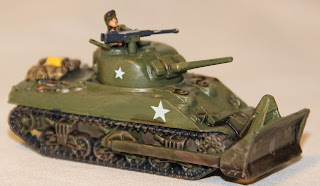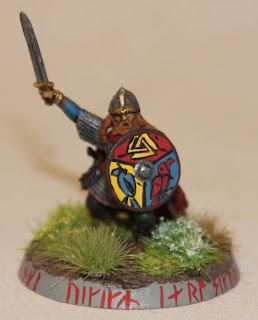All of these are in 15mm scale (or 1/100th scale), and were painted with Flames of War in mind, which makes me even more annoyed that I can't appreciate (or stand) the rules as they are in the new version.
Anyway, let's do an inventory together.
First up is Able Company. These are in fact some of the first 15mm models I painted, and it's noticeable in places. There's also a fair bit of wear and tear (especially machine guns that's been broken of, or lost a barrel). I've considered repairing and repainting these, and if/when I get back into 15mm World War 2 tabletop again, I think I will (the good thing about historical games, you're not tied to a single rules system, so when that rules system goes belly up or becomes unpalatable, it's just to get a new rule system).
First up, first platoon. 5 Sherman M4A1 with 76mm guns. They painted for Normandy '44, but can of course be used for games (and lists) set later than that as well. It's just that the black camo was mostly used (as far as I could tell) during Normandy, after that the US army simply didn't bother with camo, the Olive Drab of the Shermans were good enough (unless it was snowing, then some kind of whitewash was used).
Second platoon, equipped with M4A1s with 75mm guns. Painted similarly to first platoon. The tank commander sitting in an open hatch serves to denote the platoon command vehicle. Furthermore, every platoon command vehicles has an air recognition panel on the engine deck or the back of the turret that is clear yellow, making identification in the heat of a game that much easier. Of course, Platoon Command Vehicle recognition is no longer quite as important in the new Flames of War rules. (no, I'm not miffed at all, what makes you think that?)
Third platoon, with another 5 M4A1(75)s. These were painted to be able to use the list for games set earlier than Normandy, as well as when playing 4th, 5th or 6th Armored Division during Normandy, before those got equipped with 76mm armed Shermans). The fact that I thus had a full company was kind of an added bonus.
Finally, the HQ for Able Company. The Company Commander, front and centre, in a Sherman M4A1, the Company Second-in-Command in an M4 to the left of the image (incidentally, my very first 15mm Sherman) and finally an M4(105mm) back and out of focus, for when it's not attached to the battalion support platoon. Initially, HQ couldn't be equipped with 76mm armed Shermans (they were only available in a single platoon during Normandy)
As lists changed and the war moved on, 76mm Shermans got a bit more widespread, and HQ units could now take them. Hence, an alternative Company Commander, in an M4A1(76). I try to always have two occupied and open hatches for Company Commanders and higher command teams, to make them somewhat easy to spot on the table.
Next up, as the war moved on and improved Shermans became available, we have Baker Company.
First platoon, equipped with a pair of M4A3E8(76), commonly known as Easy Eights, an M4A3E2 Jumbo, as well as a pair of more ordinary M4A3s, one with a 105mm gun, the other with a 75mm gun. This platoon has on occasion been nicknamed the Anvil, since that's more or less how it's used, as a barely moveable, surprisingly resilient piece of hardware for the enemy to be crushed upon.
Second platoon is somewhat similarly equipped, with a pair of M4A3(76) and a pair of M4A3(75). Fifth tank (or first, since it's the platoon commander when present) is another M4A3E2 Jumbo. Has been nicknamed the hammer, since (when without the Jumbo), it can be used to flank around and drive enemies onto the anvil.
Third platoon does not have quite as refined a role. A pair of M4A3(76) and a trio of M4A3(75)s, with the better part of an infantry company allotment of sandbags to provide some extra protection.
Finally, the HQ. Another M4A3E8, Daring, and an M4A3E2 Jumbo equipped with an 76mm gun (a common field conversion), ironically named Speedy. Finally, the company recovery vehicle.
Add to that the battalion support platoon of 6 M4A3(105) Shermans... well, strictly the platoon only had 3 105's, but another 3 were allocated to the 3 Medium Tank Companies in the battalion, and commonly regrouped to the support platoon. Anyway, add those...
... and a Sherman equipped with a bulldozer (always useful to have, as long as you don't mind loosing the hull machine gun).
And then a Battalion Commander. Well strictly, this is a specific Hero, Creighton Abrams (awesome dude and tank commander). The observant might note that there's two tanks. These are both Creighton Abrams, in his Thunderbolt VI (left), an M4A3(76), and his Thunderbolt VII (right), an M4A3E8(76) he got once Thunderbolt VI was run into the ground during the Battle of the Bulge.
Anyway, add all that, Able Company...
... and Baker Company...
... and you get the better part of a Tank Battalion. A Tank Battalion consisted of 3 Medium Tank Companies equipped with Shermans (and I have 2), one Light Tank Company with M3/M5 Stuarts or, later in the war, M24 Chaffees (I currently have a single platoon of 5 M5 Stuarts), a Battalion HQ with 2 Shermans, a platoon of 105mm Shermans (seen above), another platoon of M4 Mortar Carriers (which I also have) and various non-armored support elements.
So. Do I have too many Shermans? Or do I not, and should instead go for that third company, and a Light Tank Company to round it off? If I were to do that, I would probably go for Baker getting more Easy Eights (3 in each of the first two platoons), moving the M4A3(76) to Charlie Companys first and second platoon (fill up with M4A3(75)s), and a platoon of early M4A1s to stand in for 1st platoon, Able Company when fielded before the introduction of 76mm guns.
/Fool out















































